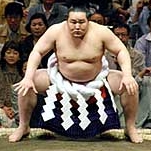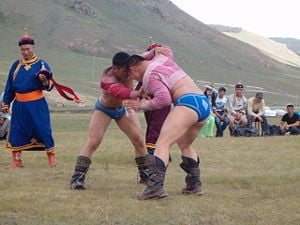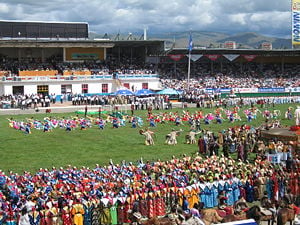Mongolian wrestling
Mongolian wrestling (Ğ±Ó©Ñ , bökh) has been a traditional sport in Mongolia for centuries. Mongolian wrestlers have an important cultural status in traditional Mongolian society and are thought to embody ancient ideals of nobility, strength and chivalrous sportsmanship. The rituals associated with Mongolian wrestling competitions are believed to have been virtually unchanged for hundreds of years. Mongolian wrestling is the highlight of Naadam (Ğаадам, games) a traditional outdoor festival held every summer in the Mongolian capital Ulaanbaatar from July 11th â 13th. It is considered one of "Three Manly Skills," along with horsemanship and archery.
Unlike Japanese sumo, there is no ring. Wrestling matches are held in the open on a grassy field, or on bare dirt. There are no weight classes. The object of a match is to get an opponent to touch his back, knee or elbow to the ground by using a variety of throws, trips and lifts (mekh). Rank can only be attained during the Naadam festival and is determined by the number of rounds won by each wrestler. Before and after the match, each wrestler does a traditional "Eagle Dance" (devekh), which has its origins in shamanistic rituals. There are two different versions of Mongolian wrestling, Mongolian (in the country of Mongolia), and Inner Mongolian (in northern China).
In recent decades, Mongolian wrestlers have adapted their skills to become champions in Chinese wrestling and in Japanese sumo wrestling. In January 2003, AsashÅryÅ« Akinori (æéé¾ æå¾³; Mongolian name, Dolgorsürengiin Dagvadorj, Mongolian: ĞолгоÑÑÒ¯ÑÑнгийн ĞагвадоÑж) became the first Mongolian to reach the highest rank of Sumo wrestling (the 68th yokozuna) in Japan. In 2005, he became the first man in history to win all six official sumo tournaments (honbasho) in a single year. Following Asashoryu, HakuhÅ ShÅ (Mongolian name, Mönkhbatyn Davaajargal, Mongolian: ĞÓ©Ğ½Ñ Ğ±Ğ°ÑÑн ĞаваажаÑгал) also achieved the highest rank in sumo wrestling. Through their success, Mongolian wrestling, which was not unknown in Japan until recently, came to be widely recognized.
Cultural and Historical Background
The sport of Mongolian wrestling (Mongolian: Ğ±Ó©Ñ , bökh) is the most popular of all Mongol sports and has existed in Mongolia for centuries in one form or another. Historians claim that Mongol-style wrestling originated some seven thousand years ago.[1]
Genghis Khan used wrestling to keep his army in good physical condition and ready for combat. Wrestling was also used occasionally as a way of eliminating political rivals; Mongol history records incidents in which the Khan arranged to have political enemies killed during a wrestling match.
The Manchu dynasty (1646-1911) Imperial court held regular wrestling events, mainly between Manchu and Mongol wrestlers.
Mongolian wrestlers and archers have an important cultural status in traditional Mongolian society. Wrestlers especially are thought to embody ancient ideals of nobility, strength and chivalrous sportsmanship. The rituals associated with Mongolian wrestling competitions are believed to have remained virtually unchanged for hundreds of years.
Mongolian wrestling is the highlight of Naadam (Mongolian: Ğаадам, games) a traditional festival held every summer in Mongolia. The main festival is held outdoors in the Mongolian capital Ulaanbaatar during a national holiday from July 11th - 13th, although other cities and towns across Mongolia have their own, smaller scale Naadam celebrations. The festival is also celebrated in the Inner Mongolia region of China. The local term for the festival is "eriin gurvan naadam" (ÑÑийн гÑÑван наадам), "three manly games." The games are Mongolian wrestling, horse racing and archery. Naadam has its origin in the activities, such as military parades and competitions in archery, horse riding and wrestling, that followed the celebration of various occasions. Now it formally commemorates the 1921 revolution when Mongolia declared itself a free country. âNaadamâ comes from the word "Naadakhâ which means âto have fun.â Naadam begins with an elaborate introductory ceremony incorporating horse riders, dancers, athletes, and musicians. After the ceremony, the competitions begin.
Ranks and matches
Wrestling matches are held in the open on a grassy field, or on bare dirt that is not too hard or littered with gravel. There are no weight classes; a small wrestler can end up wrestling someone twice his size.
Only men compete in Mongolian wrestling. Usually 512 wrestlers from different cities and aimags enter the Naadam competition and final eliminations are decided after nine rounds. The wrestler with the most victories and highest title decides who his opponents will be after the third round of eliminations. Traditionally, the host of a naadam had the privilege of choosing opponents and arranging matches, often in ways that gave his favorites the upper hand. These arrangements sometimes resulted in serious disputes between hosts and visiting wrestlers. The modern wrestling code instituted in 1980 stipulates that opponents be selected by drawing lots at major cross-regional naadams and specialized wrestling championship matches; in local competitions the traditional system still holds sway.
The number of contestants in a Mongolian-style wrestling match must be a power of two and the contest follows a single-elimination system. Rank can only be attained during the Naadam festival. The number of rounds won by each wrestler determines rank. In ascending order, the ranks are: unranked, Falcon (Nachin, 5th round), Elephant (Zaan, 7th round), Lion (Arslan, 9th round) and Titan (Avarga, the winner from among Lion rank). Every subsequent victory at the national Naadam-festival adds an epithet to the title of Avarga, such as "Invincible Titan," "Invincible Titan to be remembered by all" and so on. The Mongolian parliament added two additional two ranks, Hawk (Hartsaga, 6th round) and Garuda (Garudi, 8th round) in 2003.[1]
Rules and combat
Wrestlers (bukh, bökh) slap their thighs to show they are ready to begin the match. Mongolian wrestlers have a range of techniques called mekhs which they utilize based on their assessment of each opponentâs strengths or weaknesses. A highly skilled Mongolian wrestler knows hundreds of mekhs. The object of a match is to get an opponent to touch his back, knee or elbow to the ground. In the Inner Mongolian version, any body part other than the feet touching the ground signals defeat. A variety of throws, trips and lifts are employed to topple the opponent. The Inner Mongolians may not touch their opponent's legs with their hands, whereas in Mongolia, grabbing an opponent's legs is completely legal. Striking, strangling or locking an opponent is illegal.
In the case of a sacrifice throw, the first wrestler to touch the ground, regardless of who threw whom, is the loser. There are no time limits in a match. Each wrestler must wrestle once per round, the winners moving on to the next round. When a wrestler loses the match, he then symbolically passes under the arm of the winner as a sign of respect (tahina uguh).
Each wrestler has a zazul who acts as both coach and herald. At the beginning of the third, fifth and seventh rounds the zazul sings the praises of his wrestler's heroic deeds. During lulls in the match the zazul slaps his wrestler on the back and exhorts him to struggle on.[2] In the final competition, all the zazuls drop in the wake of each wrestler as he takes steps toward his opponent.
Dance
Before and after the match, each wrestler does the traditional "Eagle Dance" (devekh), based on the flight of the mythical Garuda bird, which symbolizes power, bravery, grace and invincibility. Different locales have different dancing styles. In Mongolia the wrestler imitates falcons or phoenix taking off (devekh). In Inner Mongolia, the dance is supposed to be a mimicking of lions or tigers prancing (magshikh)âas represented by the Ãjümchin version. Another major variation, popular among Mongols of Inner Mongolia's northeastern Khülünbüir region, resembles deer bounding (kharailtaa). The Ãjümchin "magshikh" dance seems more strikingly robust-looking, partly due to the wrestlerâs dazzling apparel and partly the style of the dance itself. In contrast, the phoenix style of Mongolia appears to exhibit a greater degree of elegance.
Mongol wrestling dance has its original forms in shamanistic rituals in which people imitated movements of various animals, combining mystical and heroic imagery with mythical symbolism. Today, apart from its aesthetic value, the dance is also regarded as a warm-up and cool-down procedure before and after an intense fight. Good wrestlers take the dance seriously and are often better dancers.
This unique dance is an integral and indispensable aspect of the wrestling tradition. In Inner Mongolia it has been formally included along with uriya, the costume, and the various rules, in the first Wrestling Competition Regulations finalized in the late 1980s.
Styles
Oirad: Resembles freestyle wrestling. The Ujumchin and Hulunbuir styles permit no moves between the legs and hands, whereas the Halh variant not only allows but requires grabbing the opponentâs legs. A Hulunbuir wrestler may kick his opponent directly in the leg(s)âa technique not sanctioned by the other styles and banned in the official code. Finally, Ordos, Alagshaa/shalbur and Oirad wrestlers begin a match with the two opponents locked together, while the Ujumchin, Khalkha and Hulunbuir styles start a bout without physical contact.
The definition of a fall varies from region to region:
The Oirad in Xingjiang (Eastern Turkestan) defines a fall as being when the shoulder blades touch the ground, which is similarly to the Turkic and international free style wrestling.
The Inner Mongol style, however, considers a fall to have occurred as soon as any part of the body above the knee (or ankle) touches the ground.
In Inner Mongolia this rule is shared by Hulunbuir, Ordos and Alagshaa/shalbur styles. The Halh variant, on the other hand, allows a hand to touch the ground without losing a bout.
Etiquette
Mongolian wrestling has its own code of etiquette. For example, when a wrestler's clothes get loose or entangled, his opponent is expected to stop attacking him and help to re-arrange themâeven though this might mean sacrificing a good opportunity to win the match.
Also, when one contestant throws the other to the ground, he is supposed to help the latter get back on his feet, before he dances his way out of the field.
Whether they have won or lost, good manners dictate that the two opponents shake hands and salute each other and the audience, both prior to and after a bout.
Costume
The standard costume of a Mongolian wrestler includes:
Jodag: A tight, collarless, heavy-duty short-sleeved jacket of red or blue color. Traditionally it was made of wool, but modern wrestlers have changed to looser materials such as cotton and silk. The front is open but tied at the bottom with a simple string knot, exposing the wrestlerâs chest. According to legend, on one occasion a wrestler defeated all other combatants, then and ripped open the jodag to reveal her breasts, showing everyone that she was a woman. From that day, the jodag had to reveal the wrestler's chest.
Shuudag: Small, tight-fitting briefs made of red or blue colored cotton cloth. These make the wrestler more mobile and prevent an opponent from taking advantage of long pants to get a better grip..
Gutal: High leather boots, either in traditional style (with slightly upturned toes), or commercial, Western style. The traditional style gutal are often reinforced around the sides with leather strings for the purpose of wrestling.
Successful wrestlers
Bat-Erdene Badmaanyambuu is considered to be the most successful champion of Mongolian wrestling since the beginning of the modern era in 1921, with 11 championship wins. He also won Naadam on the 750th anniversary of the writing of the Secret History of the Mongols in 1990.
Mongolian wrestlers in China and Japan

The First "Beijing Chinese Wrestling Open Championship Match" (shoujie beijing zhongguoshi shuaijiao leitai dasai) took place October 23, 1999, in Beijing. Three Mongol wrestlers took part in the competition and took two championships out of the three available weight categories. The heavy weight champion title went to Temur and the medium weight championship was taken by Su Soyol, both well-known Mongolian wrestlers from the East Ujumchin Banner of Inner Mongolia.
During the last decade Mongolian wrestlers have experienced remarkable success in Japanese sumo by adapting traditional Mongolian wrestling techniques and strength training.[2] AsashÅryÅ« Akinori (æéé¾ æå¾³), born Dolgorsürengiin Dagvadorj in Ulaanbaatar, Mongolia became the first Mongolian to reach sumo's highest rank in January 2003. He is the 68th yokozuna in the history of the sport in Japan. In 2005 he became the first man to win all six official sumo tournaments (honbasho) in a single year.
See also
- Sumo
- Ssireum
Notes
- â 1.0 1.1 Mongoliana, Mongolian Wrestling Retrieved August 15, 2008.
- â 2.0 2.1 Mongolia Culture Blog, Mongolian Wrestling Retrieved August 15, 2008.
ReferencesISBN links support NWE through referral fees
- Dashtï¸ s︡ÄrÄn, B. The history and culture of Mongolia. Calcutta: The Asiatic Society, 1997.
- Jagchid, Sechin, and Paul Hyer. Mongolia's culture and society. Boulder, Colo: Westview Press, 1979. ISBN 0891583904 ISBN 9780891583905
- May, Timothy Michael. Culture and customs of Mongolia. Westport, Conn: Greenwood Press, 2008. ISBN 9780313339837 ISBN 031333983X
- Mia︢g︡mar, Shagdaryn. Mongol bȯkh naadam. Ulaanbaatar: Toonot Print KhÄvlÄkh UÌÄldvÄr, 2001.
- Pang, Guek-cheng. Mongolia. Cultures of the world. Singapore: Times Books International, 1999. ISBN 9812048669 ISBN 9789812048660
External links
All links retrieved June 1, 2025.
- Mongolian Wrestling, Mongolian Cultural Blog.
Credits
New World Encyclopedia writers and editors rewrote and completed the Wikipedia article in accordance with New World Encyclopedia standards. This article abides by terms of the Creative Commons CC-by-sa 3.0 License (CC-by-sa), which may be used and disseminated with proper attribution. Credit is due under the terms of this license that can reference both the New World Encyclopedia contributors and the selfless volunteer contributors of the Wikimedia Foundation. To cite this article click here for a list of acceptable citing formats.The history of earlier contributions by wikipedians is accessible to researchers here:
The history of this article since it was imported to New World Encyclopedia:
Note: Some restrictions may apply to use of individual images which are separately licensed.

